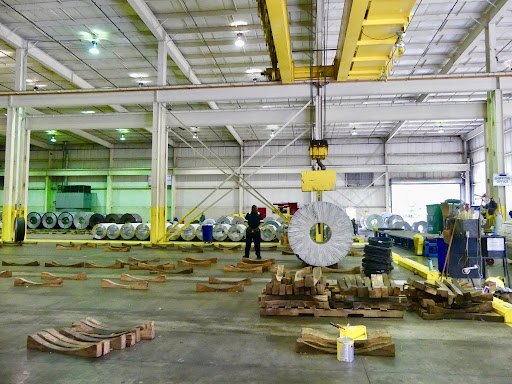A Quick Stainless Steel FAQs Guide
Pacesetter is one of the top steel service centers in the country. We offer a variety of steel products and steel services to clients from various industries. Stainless steel is one of the most popular types of steel. There are plenty of frequently asked questions about the steel, so we wanted to give you quick answers. Check out part one of our stainless steel guide below:
How to Blacken Stainless Steel
Use a liquid concentrate solution such as a black oxide to blacken stainless steel. You can blacken stainless steel at both room temperatures (65–85° F) and hot temperatures (250–260° F). Blackening steel at room temperatures is safe to do at home and leaves a satiny, grey-black finish. Blackening steel at hot temperatures results in glossy black-blue coatings and true black-oxide magnetite finishes.
Can You Braze Stainless Steel?
Brazing is the process of joining two separate pieces of metal together. Stainless steel is an excellent pick to produce high-quality brazed joints since it is corrosion resistant, strong, and results in a smooth, clean finish. The best method to braze stainless steel is flux brazing. Flux protects the base and filler metals from oxidation and limits surface tension effects. Learn about complete brazing steps here.
Which is Better: Stainless Steel or Sterling Silver?
Both stainless steel and sterling silver have their advantages and disadvantages. Stainless steel is corrosion-resistant, durable, scratch-resistant, cheaper than silver, easy to clean, and versatile. However, sterling silver is an affordable, precious metal. It’s malleable, easy to clean, and can be easily repaired. Stainless steel is hard to fix if damaged and may create allergic reactions. Sterling silver is prone to damage and tarnishing compared to stainless steel.
How to Tell If Something is Stainless Steel
Since stainless steel and aluminum are very similar in appearance. Many people wonder how to know which is which. There are many methods to tell if something is stainless steel:
- Use a magnet. It is stainless steel if the material is magnetic since aluminum is not magnetic.
- Stainless steel is heavier than aluminum.
- Break off a small piece with a hammer, and if the inside of the material is light gray or shiny, it’s most likely stainless steel.
- Some stainless steel objects commonly have an ‘S’ marketing label.
- Use an eyedropper to drop a few drops of muriatic acid on the metal. After an hour, wipe off the acid, and if the metal is discolored, it is stainless steel.
Is Stainless Steel Hypoallergenic?
Hypoallergenic metals have a low chance of causing an allergic reaction. The most common metals that cause allergic reactions are copper, zinc, and nickel. Stainless steel typically has other metals in it, including chromium or titanium. Some stainless steels have small amounts of nickel but typically not enough to cause allergic reactions. You can find nickel-free stainless steel that is 100% hypoallergenic.
Is Stainless Steel Waterproof?
Typically, most stainless steel is fairly water-resistant, making it a popular material for jewelry manufacturing. Stainless steel may become damaged in high salinity water where air circulation is poor, which will cause it to rust. Also, swimming pools treated with chlorine may damage stainless steel.
Is Stainless Steel Ferrous?
A ferrous metal has magnetic properties. Since magnets are attracted to iron, stainless steel and other types of steel are ferrous. Follow the link to learn about the differences between iron vs. steel.
Does Stainless Steel Rust or Tarnish?
A tarnished metal has lost its luster due to exposure to air or moisture. Stainless steel may become tarnished, but owners can quickly restore their item using a scouring pad, hot water, and vinegar. However, the protective film on stainless steel prevents it from rusting easily.
Is Stainless Steel Recyclable?
Steel is one of the most recycled metals on the planet. Cheaper alternatives to stainless steel, such as fiberglass or polyvinyl, are not recyclable and can have devastating environmental consequences. Stainless steel is commonly recycled and melted down. The majority of stainless steel manufactured today comes from previously recycled material.
What is Monochromatic Stainless Steel?
Monochromatic means a material is one color. Particular stainless steel appliances have painted handles or other non-stainless steel parts to result in a monochromatic appliance.
How to Remove Paint from Stainless steel
There are several DIY techniques to remove paint from stainless steel. Dampen a clean rag with turpentine and rub the paint stains. Rinse with water and use Bon Ami to finish the surface. You can also substitute lacquer thinner to remove paint from stainless steel instead of turpentine.
Need Steel For Your Next Project?
We offer custom steel products processed and finished to our clients’ exact specifications. We offer cold-rolled steel, aluminized steel, galvanized steel, galvanneal steel, and bonderized steel.
Learn more about our comprehensive, advanced steel services below and fill out the contact form below to receive a custom quote from our team:
- Steel slitting services
- Steel blanking services
- Steel cut-to-length services
- Toll-processing steel services
- Prepainted steel services
- Embossed steel services
- Perforated steel services
- Fabricated steel services
If you have more questions about stainless steel, make sure to check out part two of our steel FAQ guide here.




